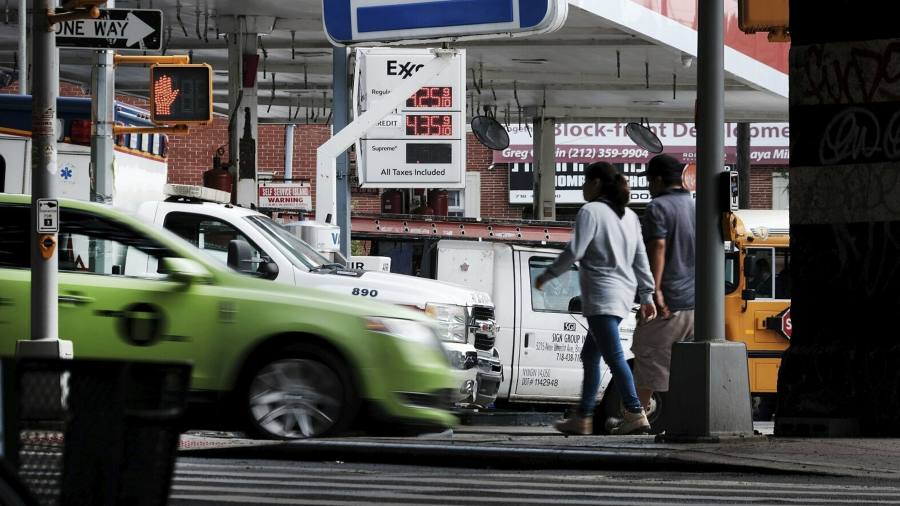[ad_1]
The retail price of US petrol has declined every day for the past nine weeks, a fact visible to motorists on signs at gas stations. Less apparent is another trend: those motorists appear to be driving less.
Weakening petrol consumption in the world’s largest consumer may be a reaction to record prices set in June above $5 a gallon. It would also be consistent with the reported slowdown in the US economy. If confirmed, it would help to loosen the global crude oil market, which has retreated close to where it traded before Russia’s invasion of Ukraine.
Measuring US fuel consumption in real time is tricky, but several information sources point to it levelling off or declining in comparison with previous summer “driving seasons”.
The US Energy Information Administration, a government statistics agency, has estimated petrol demand averaged 8.9mn barrels a day over the four weeks to August 5, marginally less than one month earlier and 6 per cent below the same period last year, when prices were $3 a gallon. Last week the EIA trimmed its full-year forecast for petrol consumption.
A survey by Oil Price Information Service of petrol stations nationwide suggested the volume of gasoline pumped last week was down around 2 per cent from a week earlier, 5 per cent from a year earlier and 19 per cent from the same period in 2019, before the start of the Covid-19 pandemic.
Travel data from the US Federal Highway Administration showed that traffic volumes hit a wall in June after consistently outstripping 2021 levels in the first five months of the year. Traffic in June, the latest month for which data were available, was 1.7 per cent — or 4.8bn vehicle miles — lower than in June 2021. In California, where petrol prices had reached above $6 a gallon, the decline was 3.5 per cent.
AAA, the motorist group, said a survey found that around two-thirds of drivers had changed their habits since March due to high prices — largely by cutting back the amount they drive and combining errands. At $3.96 a gallon on Monday, petrol prices were down by more than a fifth from their mid-June peak and below $4 for the first time in nearly six months, according to AAA.
“It has not catalysed gasoline demand,” said Tom Kloza, head of oil analysis at Opis. “Even though we’ve been dealing with lower prices . . . demand hasn’t been juiced up.”
Petrol prices may not be the most significant factor determining whether Americans return to the roads, said Giovanni Circella, an expert in travel behaviour at University of California, Davis. Employers tightening up return-to-work rules or another pandemic wave could supersede any price moves.
A jump in joblessness — the US unemployment rate was at a historically low 3.5 per cent last month — as rising interest rates cool off the economy could also cut demand from car-bound commuters. A combination of the largest expanse of paved roadways in the industrialised world and poor public transport in many parts of the US means that many people have no option but to drive.
Mobility data from analytics firm Inrix suggested passenger traffic was running at about 93 per cent of pre-Covid levels this summer but was roughly on par with last year.
“Driving is relatively inelastic, meaning that a large change in price only causes a small change in driving,” said Bob Pishue, an analyst at Inrix. “In the vast majority of the country there aren’t alternatives to driving.”
Analysts said the latest price drop below a psychological threshold will have an effect. “I think getting below the $4 mark is going to be significant. I think we will see people react to it positively,” said Prashant Malaviya, a marketing professor at Georgetown University. “It will have a disproportionate impact on the perception or the emotional response that things are getting better.”
Oil refiners say the market remains tight after a large amount of capacity was taken offline during the pandemic. Gary Simmons, chief commercial officer at Valero Energy, told analysts recently that the company had seen a “bit of a lull” in early July but that demand had since recovered to June levels.
Over the long term, high fuel prices could accelerate the adoption of electric vehicles in the US — just as they drove sales of hybrid vehicles in the early 2000s. That would support efforts to shift away from combustion engines through tax incentives that were included in the climate bill that passed Congress last week.
“One potential impact [of higher prices] is that we are going to see more fuel efficiency gains — a new wave of increasing fuel efficiency — but the other big thing is that we are going to see more and more electric vehicles on the road,” said Circella. “With the government push supporting that, high gas prices might actually help quite a bit.”
[ad_2]
Image and article originally from www.ft.com. Read the original article here.

